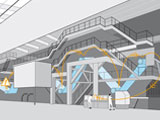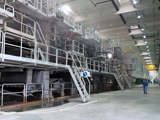Batteryless radio solution reaches pilot stage


Systems for condition monitoring should, ideally, detect faults before a machine comes to a standstill. Until now, this type of sensor system has only been used with very valuable drives for reasons of cost. Those days are gone. Fraunhofer IZM, together with partners, has developed batteryless radio solutions that have now been tested successfully for the first time.
Within the publicly funded joint project "Energy-independent Condition Monitoring System" (Ecomos), the application field of wireless radio sensoring was expanded to included condition monitoring of industrial machinery. The project also seeks to widen significantly the application area of condition monitoring. "Wireless sensor networks, through distributed data capture and communication, open up completely new possibilities in measuring technology and may even revolutionize it in the years to come," according to Dr. Michael Niedermayer, group manager for technology-oriented design methods at the project partner Fraunhofer Institute for Reliability and Microintegration IZM in Berlin.
Successful practical test in a paper factory
The first radio sensor nodes were set up and successfully tested in a paper factory. Sensors, data processing, radio interface, and energy supply were separate modules in the first prototype generation. In the second prototype generation, the modules were united in a particularly compact and robust structure. These radio sensor nodes are now available.
The concept of radio sensors for condition monitoring is based on condition monitoring of machines. The sensors measure and analyze vibrations and temperatures. This allows them to predict bearing damage up to three months in advance. The sensor nodes are configured via a radio transmitter and receiver and regularly transmit the machine condition to a base station up to 50 meters away. If the sensor nodes discover a pattern indicative of damage, they radio the raw data to a control station via a base station.
Convenient use of sensors
Progress in microelectronics and microsystem technology now allows energy-independent radio sensors to be produced at moderate cost. In addition to precise sensoring, powerful data processing and the radio connection, the energy supply is another important focus of hardware design when it comes to designing maintenance-free radio sensor nodes. Users in the industry prefer solutions with energy converters to battery-operated radio technology. Thermogenerators and vibration converts offer a good way of harvesting energy from the surroundings. This means that battery changing can be dispensed with, increasing operating reliability.
Radio sensor installation is convenient as well. When a sensor node is attached to a machine and activated, it detects existing radio networks and logs in. The radio base stations make it possible to adapt the sensor nodes by radio and to update their software.
Depending on the requirements and the usage environment, the material costs for a sensor node are between ten and 200 euros. These lower costs may open the door to new business fields for machine construction with additional service concepts, and may contribute to a better understanding of technical systems.
The "Ecomos" project
The companies IMC-Messsysteme, Elbau, Gesellschaft für Maschinendiagnose, Converteam, Baumer-Hübner, and Enocean are involved in the development of radio sensor nodes, as well as Fraunhofer IZM and the Technische Universität Berlin. The project was funded by the German Federal Ministry of Education and Research (BMBF); the project manager is VDI/VDE Innovation + Technik GmbH in Berlin.
Last modified:
 Fraunhofer Institute for Reliability and Microintegration IZM
Fraunhofer Institute for Reliability and Microintegration IZM